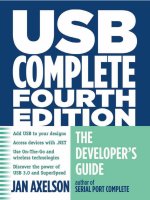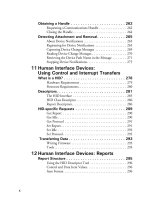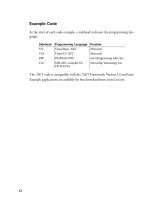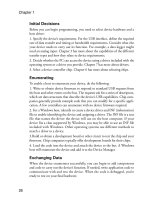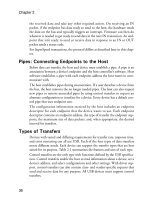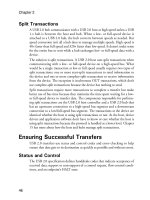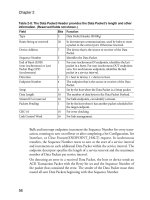USB Complete fourth- P13 docx
Bạn đang xem bản rút gọn của tài liệu. Xem và tải ngay bản đầy đủ của tài liệu tại đây (222.53 KB, 10 trang )
Chapter 4
96
&GXKEG4GOQXCN
When a user removes a device from the bus, the hub disables the device’s port.
The host knows that the removal occurred after the hub notifies the host that
an event has occurred, and the host sends a Get Port Status request to learn
what the event was. The device disappears from the Device Manager and the
device’s address becomes available to another newly attached device.
6KRUHQT5WEEGUUHWN'PWOGTCVKQP
Without successful enumeration, the device and host can’t perform other com-
munications. Most chip companies provide example code, which can serve as a
model even if your application doesn’t exactly match the example application. If
your controller interfaces to an external CPU, you may have to adapt code writ-
ten for another chip.
In general, a device should assume nothing about what requests or events the
host will initiate and should concentrate on responding to requests and events
as they occur. The following tips can help avoid problems.
Don’t assume requests or events will occur in a specific order. Some
requests, such as Set Configuration, require the device to be in the Address or
Configured state, so the request is valid only after the device has accepted a Set
Address request. But the host has some flexibility in what requests to issue and
in what order during enumeration. A host might also reset or suspend the bus
at any time, and the device must detect the event and respond appropriately.
Be ready to abandon a control transfer or end it early. On receiving a new
Setup packet, a device must abandon any transfer in progress and begin the new
one. On receiving an OUT token packet (USB 2.0) or STATUS Transaction
Packet (SuperSpeed), the device must assume that the host is beginning the Sta-
tus stage of the transfer even if the device hasn’t sent all of the requested data in
the Data stage.
Don’t attempt to send more data than the host requests. In the Data stage of
a control read transfer, a device should send no more than the amount of data
the host has requested. If the host requests nine bytes, the device should send
no more than nine bytes.
Send a zero-length data packet when required. In some cases, the device
returns less than the requested amount of data, and the amount of data is an
exact multiple of the endpoint’s maximum packet size. On receiving a request
Enumeration: How the Host Learns about Devices
97
for more data, the device should indicate that it has no more data by returning
a ZLP (USB 2.0) or a zero-length Data Payload (SuperSpeed).
Stall unsupported requests. A device shouldn’t assume it knows every request
the host might send. The device should return a STALL in response to any
request the device doesn’t support.
Don’t set the address too soon. In a Set Address request, the device should set
its new address only after the Status stage of the request is complete.
Be ready to enter the Suspend state. A host can suspend the bus when the
device is in any powered state, including before the device has been configured.
When the bus is suspended, the device must reduce its use of bus power.
Test under different host-controller types. Some full-speed host controllers
schedule multiple stages of a control transfer in a single frame, while others
don’t. Devices should be able to handle either way. Chapter 8 has more about
host controllers.
&GUETKRVQTU
USB descriptors are the data structures that enable the host to learn about a
device. Each descriptor contains information about the device as a whole or an
element in the device.
All USB devices must respond to requests for the standard USB descriptors.
The device must store the contents of its descriptors and respond to requests for
the descriptors.
6[RGU
Table 4-1 lists the descriptors defined in the USB 2.0 and USB 3.0 specifica-
tions. Except for compound devices, each device has one and only one device
descriptor that contains information about the device and specifies the number
of configurations the device supports. For each configuration, each device has a
configuration descriptor with information about the device’s use of power and
the number of interfaces the configuration supports. For each interface, the
device has an interface descriptor that specifies the number of endpoints. Each
endpoint has an endpoint descriptor that contains information needed to com-
municate with the endpoint. An interface with no endpoint descriptors uses the
control endpoint for all communications.
On receiving a request for a configuration descriptor, a device should return the
configuration descriptor and all of the configuration’s interface, endpoint, and
Chapter 4
98
other subordinate descriptors up to the requested number of bytes. A host can’t
request to retrieve, for example, only an endpoint descriptor. Devices that sup-
port both full and high speeds support two additional descriptor types:
device_qualifier and other_speed_configuration. These and their subordinate
descriptors contain information about the device when using the speed not cur-
rently in use.
SuperSpeed devices must provide a binary device object store (BOS) descriptor
and at least two subordinate device capability descriptors: a SuperSpeed USB
Table 4-1: The bDescriptorType field in a descriptor contains a value that
identifies the descriptor type.
D&GUETKRVQT6[RG &GUETKRVQT6[RG 4GSWKTGF!
01h device Yes.
02h configuration Yes.
03h string No, unless a driver requires it. Optional
descriptive text.
04h interface Yes.
05h endpoint Yes, to use other than endpoint zero.
06h device_qualifier Yes for devices that support both full and
high speeds. Not allowed for other devices.
07h other_speed_configuration Yes for devices that support both full and
high speeds. Not allowed for other devices.
08h interface_power No (proposed but never approved or
implemented).
09h OTG Yes for On-The-Go devices.
0Ah debug No.
0Bh interface_association Yes for some composite devices.
0Ch security For wireless devices.
0Dh key
0Eh encryption type
0Fh binary device object store
(BOS)
Yes for SuperSpeed devices, wireless
devices, and devices that support link
power management.
10h device capability
11h wireless endpoint
companion
For wireless devices.
30h SuperSpeed_endpoint_
companion
Yes for SuperSpeed devices. Not supported
for other speeds.
Enumeration: How the Host Learns about Devices
99
descriptor and a USB 2.0 Extension descriptor. Other devices may also use
BOS and device capability descriptors. Every SuperSpeed endpoint descriptor
has a subordinate SuperSpeed endpoint companion descriptor.
A string descriptor can store text such as the vendor’s or device’s name or a serial
number. Another descriptor may contain an index value that points to the
string descriptor. The host reads string descriptors using Get Descriptor
requests.
Class- and vendor-specific descriptors offer a structured way for a device or
interface to provide more detailed information about a function. For example,
if an interface descriptor specifies that the interface belongs to the HID class,
the interface also has a HID class descriptor.
Standard descriptors begin with a bLength byte that gives the descriptor’s
length in bytes followed by a bDescriptorType byte that identifies the descrip-
tor’s type. Table 4-1 shows values for standard descriptor types.
In a Get Descriptor request, the Setup stage’s data packet passes wValue and
wLength values to the device. The wValue field identifies the descriptor being
requested. The wLength field is the number of bytes the host is requesting from
the device. Chapter 5 has more about the Get Descriptor request.
Some class- or vendor-specific descriptors modify or extend other descriptors.
In the descriptors returned in response to a request for a configuration and sub-
ordinate descriptors, a descriptor that extends or modifies a descriptor follows
that descriptor. Like standard descriptors, these class- and vendor-specific
descriptors begin with a bLength byte followed by a bDescriptorType byte.
For descriptors that don’t modify or extend a standard descriptor, such as a
request for a HID-class report descriptor, the host uses a Get Descriptor request
that specifies the class- or vendor-specific descriptor type and the index of the
request. The class or vendor defines the format for these descriptors.
Each descriptor below begins with bLength and bDescriptorType fields. The
other fields vary with the descriptor type.
&GXKEG
The device descriptor is the first descriptor the host reads on device attachment.
The descriptor contains information the host needs to retrieve additional infor-
mation from the device. A host retrieves a device descriptor by sending a Get
Descriptor request with the high byte of the Setup transaction’s wValue field
equal to 01h.
Chapter 4
100
The descriptor (Table 4-2) provides information about the device, its configura-
tions, and any classes the device belongs to.
bcdUSB is the USB specification version that the device and its descriptors
comply with in BCD (binary-coded decimal) format. If you think of the ver-
sion’s value as a decimal number, the upper byte represents the integer, the next
four bits are tenths, and the final four bits are hundredths. USB 1.1 is 0110h
(not 0101h). USB 2.0 is 0200h. USB 3.0 is 0300h.
A device with bcdUSB = 0210h or higher must support the BOS descriptor. A
device or device wire adapter that complies with Wireless USB V1.0 should set
bcdUSB to 0250h.
bDeviceClass specifies the device’s class for devices whose function is defined at
the device level. Values from 01h to FEh are reserved for classes defined by USB
specifications. Table 4-3 shows defined codes. Vendor-defined classes use FFh.
Most devices specify their class or classes in interface descriptors. For these
devices, bDeviceClass in the device descriptor equals 00h if the function doesn’t
use an interface association descriptor or EFh if the function uses an interface
association descriptor.
Table 4-2: The device descriptor identifies the product and its manufacturer, sets
the maximum packet size for endpoint zero, and can specify a device class.
1HHUGV
FGEKOCN
(KGNF 5K\G
D[VGU
&GUETKRVKQP
0 bLength 1 Descriptor size in bytes (12h)
1 bDescriptorType 1 The constant DEVICE (01h)
2 bcdUSB 2 USB specification release number (BCD)
4 bDeviceClass 1 Class code
5 bDeviceSubclass 1 Subclass code
6bDeviceProtocol1Protocol Code
7 bMaxPacketSize0 1 Maximum packet size for endpoint zero
8 idVendor 2 Vendor ID
10 idProduct 2 Product ID
12 bcdDevice 2 Device release number (BCD)
14 iManufacturer 1 Index of string descriptor for the manufacturer
15 iProduct 1 Index of string descriptor for the product
16 iSerialNumber 1 Index of string descriptor for the serial number
17 bNumConfigurations 1 Number of possible configurations
Enumeration: How the Host Learns about Devices
101
bDeviceSubclass can specify a subclass within a class. A subclass can add sup-
port for additional features and abilities shared by a group of functions in a
class. If bDeviceClass is 00h, bDeviceSubclass must be 00h. If bDeviceClass is
in the range 01h–FEh, bDeviceSubclass equals 00h or a code defined for the
device’s class. Vendor-defined subclasses in standard classes use FFh.
bDeviceProtocol can specify a protocol for the selected class and subclass. For
example, a USB 2.0 hub uses this field to indicate whether the hub is currently
supporting high speed and if so, if the hub supports one or multiple transaction
translators. If bDeviceClass is in the range 01–FEh, the protocol equals 00h or
a code defined by the device’s class.
bMaxPacketSize0 specifies the maximum packet size for endpoint zero. The
host uses this information in the requests that follow the request for the device
descriptor. For USB 2.0, the maximum packet size equals the field’s value and
must be 8 for low speed; 8, 16, 32, or 64 for full speed; and 64 for high speed.
For SuperSpeed, the maximum packet size equals 2
bMaxPacketSize0
and
bMaxPacketSize0 must equal 9 to specify a maximum packet size of 512.
Table 4-3: The bDeviceClass field in the device descriptor can name a class the
device belongs to.
D&GXKEG%NCUU &GUETKRVKQP
00h The interface descriptor specifies the class and the function doesn’t use an
interface association descriptor. (See EFh below.)
02h Communications device (can instead be declared at the interface level)
09h Hub
0Fh Personal healthcare device (declaring at the interface level preferred)
DCh Diagnostic device (can instead be declared at the interface level)
bDeviceSubclass = 01h, bDeviceProtocol = 01h: USB2 Compliance Device
E0h Wireless Controller (can instead be declared at the interface level)
bDeviceSubclass = 01h: Bluetooth programming interface
EFh Miscellaneous
bDeviceSubclass = 01h
bDeviceProtocol = 01h: active sync
bDeviceProtocol = 02h: Palm sync
bDeviceSubclass = 02h
bDeviceProtocol = 01h: interface association descriptor
bDeviceProtocol = 01h: wire adapter multifunction peripheral (Wireless
USB).
FFh Vendor-specific (can instead be declared at the interface level)
Chapter 4
102
idVendor is a Vendor ID assigned by the USB-IF to members of the USB-IF
and others who pay an administrative fee. The host may have an INF file that
contains this value, and if so, Windows may use the value to help select a driver
for the device. Except for devices used only in house where the user is responsi-
ble for preventing conflicts, every device descriptor must have a valid Vendor
ID in this field.
idProduct is a Product ID that identifies the vendor’s device. The owner of the
Vendor ID assigns the Product ID. Both the device descriptor and the device’s
INF file on the host may contain this value, and if so, Windows may use the
value to help select a driver for the device. Each Product ID is specific to a Ven-
dor ID, so multiple vendors can use the same Product ID without conflict.
bcdDevice is the device’s release number in BCD format. The vendor assigns
this value. The host may use this value to help select a driver for the device.
iManufacturer is an index that points to a string describing the manufacturer
or zero if there is no manufacturer descriptor.
iProduct is an index that points to a string describing the product or zero if
there is no string descriptor.
iSerialNumber is an index that points to a string containing the device’s serial
number or 00h if there is no serial number. Serial numbers are useful if users
may have more than one identical device on the bus and the host needs to
remember which device is which even after rebooting. A serial number also
enables a host to determine whether a device is the same one used previously or
a new installation of a device with the same Vendor ID and Product ID.
Devices with the same Vendor ID, Product ID, and device release number
should not share a serial number. Mass-storage devices that use the bulk-only
protocol must have serial numbers.
bNumConfigurations equals the number of configurations the device supports
at the current operating speed.
&GXKEGA3WCNKHKGT
Devices that support both full and high speeds must have a device_qualifier
descriptor (Table 4-4). When a device switches speeds, the values of some fields
in the device descriptor may change. The device_qualifier descriptor contains
the values for these fields at the speed not currently in use. In other words, the
contents of fields in the device and device_qualifier descriptors swap depending
on which speed is in use. A host retrieves a device_qualifier descriptor by send-
Enumeration: How the Host Learns about Devices
103
ing a Get Descriptor request with the high byte of the Setup transaction’s
wValue field equal to 06h.
The Vendor ID, Product ID, device release number, manufacturer string, prod-
uct string, and serial-number string don’t change when the speed changes, so
the device_qualifier descriptor doesn’t include these fields.
%QPHKIWTCVKQP
After retrieving the device descriptor, a host can retrieve the device’s configura-
tion, interface, and endpoint descriptors.
Each device has at least one configuration that specifies the device’s features and
abilities. Typically a single configuration is enough, but with driver support, a
device with multiple uses or multiple options for power use can support multi-
ple configurations. Only one configuration is active at a time. Each configura-
tion requires a descriptor with information about the device’s use of power and
the number of interfaces supported (Table 4-5). Each configuration descriptor
has subordinate descriptors, including one or more interface descriptors and
optional endpoint descriptors. A host retrieves a configuration descriptor and
its subordinate descriptors by sending a Get Descriptor request with the high
byte of the Setup transaction’s wValue field equal to 02h and the wLength field
equal to wTotalLength.
Table 4-4: In a device that supports both full and high speeds, the
device_qualifier descriptor contains information about the device when
operating in the speed not currently in use.
1HHUGV
FGEKOCN
(KGNF 5K\G
D[VGU
&GUETKRVKQP
0 bLength 1 Descriptor size in bytes (0Ah)
1 bDescriptorType 1 The constant DEVICE_QUALIFIER (06h)
2 bcdUSB 2 USB specification release number (BCD)
4 bDeviceClass 1 Class code
5 bDeviceSubclass 1 Subclass code
6 bDeviceProtocol 1 Protocol Code
7 bMaxPacketSize0 1 Maximum packet size for endpoint zero
8 bNumConfigurations 1 Number of possible configurations
9 Reserved 1 For future use
Chapter 4
104
The host selects a configuration with the Set Configuration request and reads
the current configuration number with a Get Configuration request.
wTotalLength equals the number of bytes in the configuration descriptor and
all of its subordinate descriptors.
bNumInterfaces equals the number of interfaces in the configuration. The
minimum is 01h.
bConfigurationValue identifies the configuration for Get Configuration and
Set Configuration requests and must be 01h or higher. A Set Configuration
request with a value of zero causes the device to enter the Not Configured state.
iConfiguration is an index to a string that describes the configuration. This
value is zero if there is no string descriptor.
bmAttributes sets bit 6 = 1 if the device is self-powered and zero if bus pow-
ered. Bit 5 = 1 if the device supports the remote wakeup feature, which enables
a suspended USB device to tell the host that the device wants to communicate.
The other bits in the field are unused. Bits 4 0 must be zero. Bit 7 must equal 1
for compatibility with USB 1.0
bMaxPower. Specifies how much bus current a device requires. For USB 2.0,
bMaxPower is in units of 2 mA. If the device requires 200 mA, bMax-
Power=64h. For SuperSpeed, bMaxPower is in units of 8 mA. The maximum
Table 4-5: The configuration descriptor specifies the maximum amount of bus
current the device will require and gives the total length of the subordinate
descriptors.
1HHUGV
FGEKOCN
(KGNF 5K\G
D[VGU
&GUETKRVKQP
0 bLength 1 Descriptor size in bytes (09h)
1 bDescriptorType 1 The constant CONFIGURATION (02h)
2 wTotalLength 2 The number of bytes in the configuration
descriptor and all of its subordinate descriptors
4 bNumInterfaces 1 Number of interfaces in the configuration
5 bConfigurationValue 1 Identifier for Set Configuration and Get
Configuration requests
6 iConfiguration 1 Index of string descriptor for the configuration
7 bmAttributes 1 Self/bus power and remote wakeup settings
8 bMaxPower 1 Bus power required in units of 2 mA (USB 2.0) or 8
mA (SuperSpeed).
Enumeration: How the Host Learns about Devices
105
bus current a device can request is 500 mA for USB 2.0 and 900 mA for Super-
Speed. If the requested current isn’t available, the host will refuse to configure
the device. A driver may then request an alternate configuration if available.
1VJGTA5RGGFA%QPHKIWTCVKQP
The second descriptor unique to devices that support both full and high speeds
is the other_speed_configuration descriptor (Table 4-6). The structure of the
descriptor is identical to that of the configuration descriptor. The only differ-
ence is that the other-speed_configuration descriptor describes the configura-
tion when the device is operating at the speed not currently in use. The
descriptor has subordinate descriptors just as the configuration descriptor does.
A host retrieves an other_speed_configuration descriptor by sending a Get
Descriptor request with the high byte of the Setup transaction’s wValue field
equal to 07h.
+PVGTHCEG#UUQEKCVKQP
An interface association descriptor (IAD) identifies multiple interfaces associ-
ated with a function (Table 4-7). In relation to a device and its descriptors, the
term interface refers to a feature or function a device implements.
Table 4-6: The other_speed_configuration descriptor has the same fields as the
configuration descriptor but contains information about the device when it
operates in the speed not currently in use.
1HHUGV
FGEKOCN
(KGNF 5K\G
D[VGU
&GUETKRVKQP
0 bLength 1 Descriptor size in bytes (09h)
1bDescriptorType1The constant
OTHER_SPEED_CONFIGURATION (07h)
2 wTotalLength 2 The number of bytes in the configuration
descriptor and all of its subordinate descriptors
4 bNumInterfaces 1 Number of interfaces in the configuration
5 bConfigurationValue 1 Identifier for Set Configuration and Get
Configuration requests
6 iConfiguration 1 Index of string descriptor for the configuration
7 bmAttributes 1 Self/bus power and remote wakeup settings
8 MaxPower 1 Bus power required in units of 2 mA (USB 2.0) or 8
mA (SuperSpeed).

